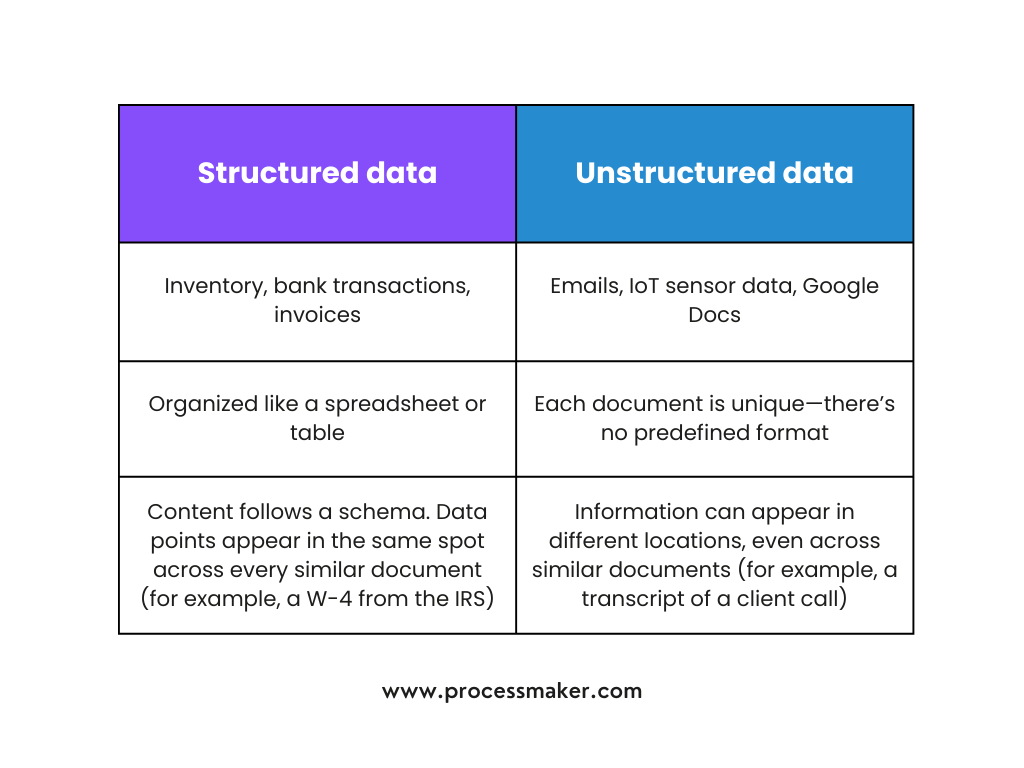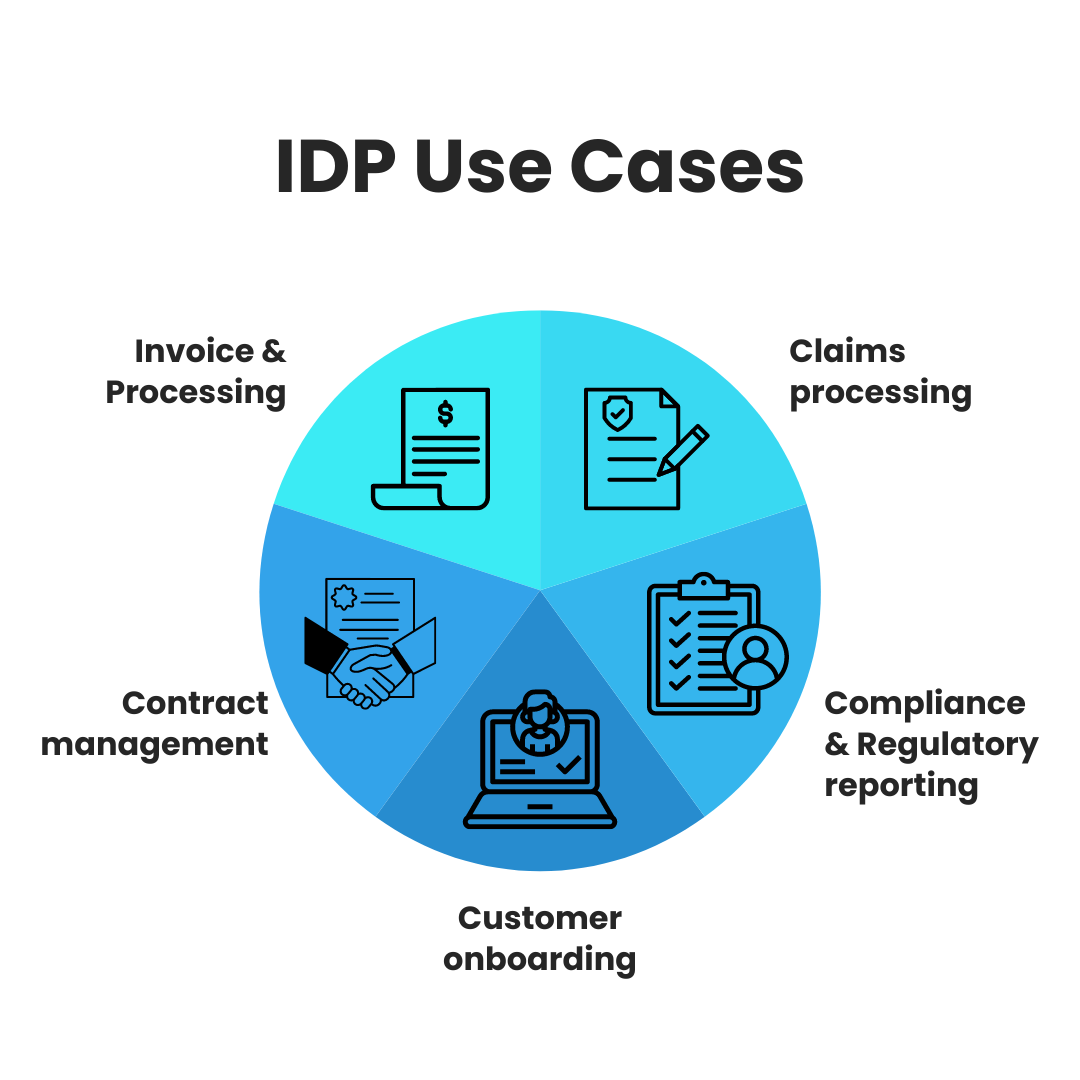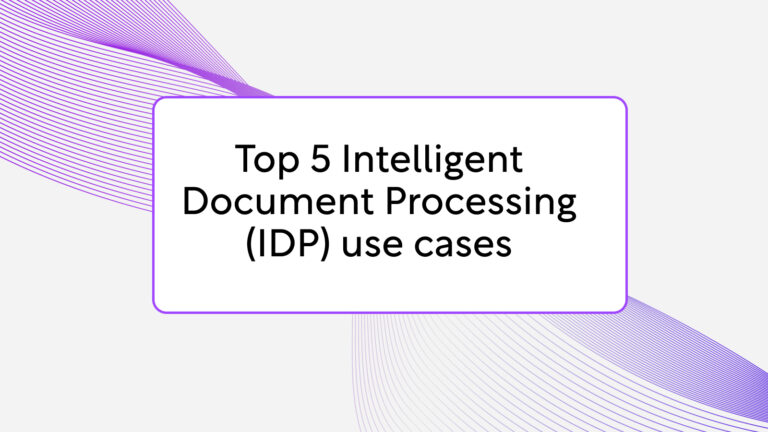Do you think of documents as static objects? That belief is changing, thanks to a document automation technology called intelligent document processing (IDP). Documents not only process themselves but become dynamic sources of information that you can analyze and act upon in real time.
This is great news, considering 60–73% of all enterprise data goes unprocessed, unnoticed, or unanalyzed. What is intelligent document processing and what are five use cases that will inspire your document automation strategy?
See for yourself! Try out the latest features of ProcessMaker Platform for free.
What is intelligent document processing?
Intelligent document processing (IDP) uses artificial intelligence and machine learning to read documents like invoices, receipts, applications, and more. It can find the desired information in a document—like the store name and amount on a receipt. It can then use that information to do things like fill out forms such as reimbursement requests, send emails, or make payments.
IDP can hone in on key data points within any document. Contracts, bank statements, and personal identification records are also prime candidates for IDP. That includes physical documents scanned and digitized, or electronic documents.
With IDP, artificial intelligence handles both types of data organizations struggle with structured and unstructured documents.

In the past, you would need to spend time restructuring data into a consistent format. For example, it wasn’t long ago that someone would need to sift through stacks of business cards collected at a conference and manually input contacts into a spreadsheet.
Intelligent document processing performs the data structuring for you, plucking information from all over a document—no matter how unexpected the placement.
Robotic process automation (RPA)
As shown above, intelligent document processing is an optimal solution for business process automation, enhancing data management and streamlining workflows across various industries, a much-needed upgrade to the capabilities of robotic process automation (RPA). Unlike IDP, RPA is much more limited in what it can do. While IDP is an intuitive solution, RPA needs to be told what to do, and can only follow specific tasks.
How does IDP work hand-in-hand with automation?
IDP facilitates the corporate Holy Grail—clean data. Intelligent document processing work involves a series of steps, including document classification, data extraction, and validation, using advanced AI technologies like natural language processing and machine learning. This win sets up your organization for success using other types of automation tools.
Most hyperautomation tech, like robotic process automation or process mining, performs infinitely better when fed clean, consistent, accurate data. This means data that follows formatting rules (think of the many ways you can write a phone number!)
For example, a mistyped name or email address can botch future communications with a client. Poor quality data is more than a typo—it winds its way through your other automated processes and snowballs.
Using a powerful IDP platform to extract information with over 99% accuracy is the first step towards taking advantage of the greater world of workflow automation.
What are the top benefits of IDP?
- Improve resource allocation. Shift the admin workload over to machines. Humans can focus more on strategy, client relations, and inventing growth opportunities.
- Reduce costs. According to one study, manual processing can cost your organization up to $9 per invoice. Today, top-performing companies use AI and automation to drive those costs down to less than $1.42. By streamlining document processing, IDP enables businesses to allocate resources more effectively and focus on strategic initiatives.
- Boost morale. Let’s face it, 40 hours per week of copy-and-paste swivel chair tasks sink employee spirits. By reducing mind-numbing data entry and allowing talent to focus on more engaging projects, you’ll build a more enthusiastic team.
- Reduce errors. In business, typos aren’t just innocent blunders; they can rack up losses and tank reputations. One Japanese security firm hoped to sell one share for 610,000 yen—but an errant keystroke sold 610,000 shares for one yen each. IDP improves accuracy in your business activities by reducing human touch points. Additionally, data extraction automates the extraction, validation, and structuring of data from documents, reducing manual effort and errors.
- Scale efficiently. Whether your business needs to process a few hundred documents or millions, IDP can handle the load. This flexibility makes it an ideal solution for businesses of all sizes, allowing them to scale up or down based on their changing needs. With IDP, you can efficiently manage large volumes of documents without compromising on accuracy or speed.
- Increase customer satisfaction. IDP enhances the customer experience by providing faster and more accurate document processing. This leads to quicker turnaround times for customers, improving their overall experience with your business.
Overall, Intelligent Document Processing (IDP) is a powerful technology that offers numerous benefits, from improving operational efficiency and reducing costs to enhancing customer satisfaction and ensuring regulatory compliance. By automating the extraction of relevant data from documents, IDP empowers businesses to make better-informed decisions and stay ahead in a competitive landscape.
See for yourself! Try out the latest features of ProcessMaker Platform for free.
The 5 IDP uses cases you need to know

Processing documents with AI accelerates data entry and analytics in all industries. It’s no surprise experts predict this $1.1 billion industry will climb to $5.2 billion over the next two years alone. Let’s explore some of the areas IDP is rewriting document management.
Invoice processing
IDP extracts key information from invoices, such as vendor details, invoice numbers, line items, and amounts. With IDP, you’ll process invoices faster and improve efficiency in accounts payable.
In the past, someone would have to open each invoice envelope, manually enter data into the company’s accounting system, and then file the invoice away. You can see how IDP can upend this slow process for the better. Using IDP, the software can automatically perform those tasks, extracting the data and routing it through to approving managers, too.
Contract management
IDP streamlines contract management by extracting data from contracts like business names, key dates, and terms and conditions. Data processing plays a crucial role in automating the extraction and organization of data from contracts, ensuring accuracy and efficiency. It speeds up contract preparation and review, reducing the risk of loading inaccurate deliverables or contact info into your workflows.
IDP does more than ingest current contracts. It can help build new ones as well. If your organization has trouble maintaining language consistency between agreements, IDP is the tool you need. Extract key terms and add them into a new agreement. Search for contracts that share obligations or find contracts that don’t match the others.
Customer onboarding
IDP gives customer onboarding a much-needed facelift. Automatically extract and verify customer data from documents such as ID cards and application forms.
Sometimes, the onboarding process includes handwritten forms and notes. Natural language processing (NLP) plays a crucial role in interpreting these handwritten forms and notes, enabling machines to understand and process human language. This is another area where document automation shines. IDP can read and interpret handwriting (even cursive!) and fill in missing characters with a high level of precision. Tax documents, patient intake, or government forms are easily turned into digital, usable forms through IDP.
Compliance and regulatory reporting
IDP helps automate the extraction and classification of data for regulatory and reporting purposes. Intelligent document processing solutions efficiently handle and organize large volumes of data from various document types, ensuring compliance by extracting valuable information without human intervention. It assists in compliance monitoring and ensures organizations stay up to date with changing rules and legislation.
You’ll find AI-powered IDP in regulation-heavy industries like banking and finance. IDP helps codify the processing of sensitive documents. It can automate Know-Your-Customer checks by handling content like:
- Proof of residence
- Utility bills
- Articles of incorporation
- Proof of income
- Signatory management cards
Industries like banking and higher education process all sorts of government IDs like passports, driver’s licenses, and vaccine records from all around the world. Tasking a human to learn the various formats can take weeks and lead to dirty data. IDP captures clean personal identification quickly and can even mask sensitive identifiers—like social security numbers—from unauthorized team members.
From there, automation can usher information through other steps. Add the information to a database, use it to populate a series of other documents, or drop it into a background check system.
Claims processing
Insurance professionals are using AL and ML to help them collect and organize documents like claims forms, medical records, and supporting evidence. IDP expedites the claims processing workflow, reduces manual effort, and improves accuracy in claims settlement. IDP also plays a crucial role in managing unstructured data in claims forms and medical records, enhancing operational efficiency and accuracy. You’ll find insurance companies using document automation to:
- Validate information: Automatically compare claims against records to flag incorrect dates or locations
- Gather information: Compiling handwritten documents, emails, and other content into one file
- Recognize missing information: When automated systems spot a missing field, they can trigger a customer communication sequence to track it down quickly.
While IDP improves operational efficiency and accuracy for claims processing, it’s also a boon to customer satisfaction. Accenture found that 31% of customers felt dissatisfied with the handling of their home or auto insurance claim. What causes the frustration? Speed—six in 10 thought the process took entirely too long. Many fled for a competing insurer due to the poor experience. Artificial intelligence can help the insurance industry retain customers and recoup the $170 billion Accenture predicts sluggish timelines will cost them.
IDP and automation – match made in heaven
The key to an effective AI document processing strategy is a partner that excels in automation, too. Simply extracting company addresses from onboarding paperwork into a spreadsheet won’t do. That information needs to move through your operations—and process automation is its shepherd.
Intelligent document processing solutions, combined with AI and process automation, help you perform actions with extracted information. Query anti-money laundering databases, ask for a list of top-performing products in Texas, and evaluate customer reviews to identify potential opportunities. With IDP + automation, information becomes usable. It becomes insight. Instead of languishing in a data repository, you can finally bring your most vital data to life.





